创建MCP服务器
我们选择用nodejs来实现bitfactory-mcp这个MCP服务器。
使用MCP官方提供的命令行工具来创建MCP服务器:
npx @modelcontextprotocol/create-server bitfactory-mcp

在终端执行上面命令,按照提示输入要创建的MCP服务器信息:
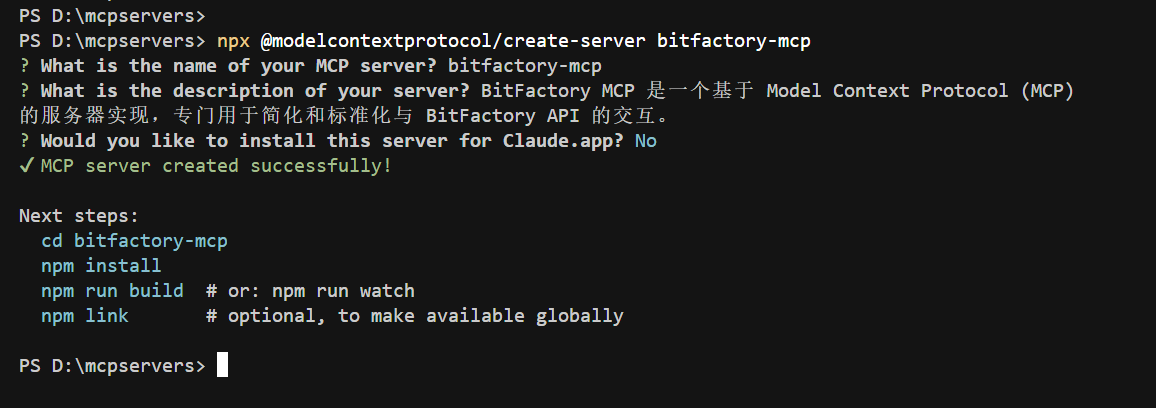
进入创建的MCP服务器目录,安装项目依赖:
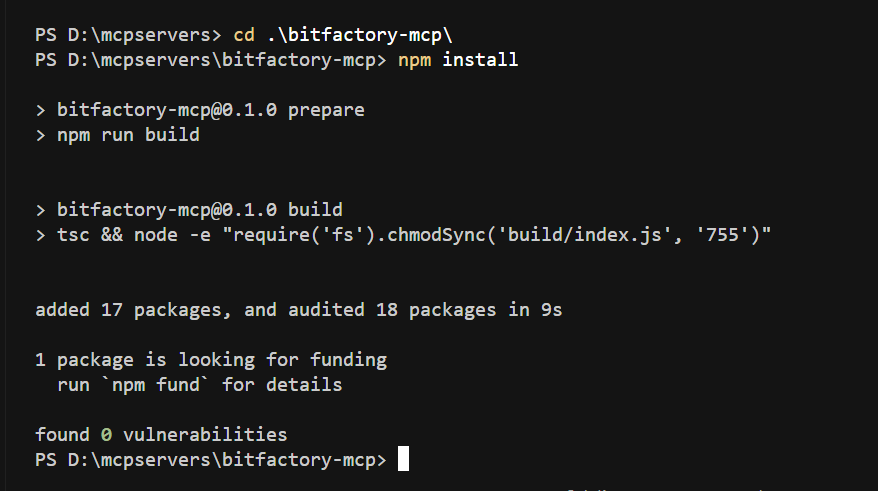
打开创建好的MCP服务器,可以看到默认生成的项目代码结构:
src/index.ts 是 MCP 服务器的源码文件,在此文件实现 MCP 服务器的业务功能,build/js 是 MCP 服务器源码编译后的可执行文件,调试阶段和发布上线,都要用到此文件。
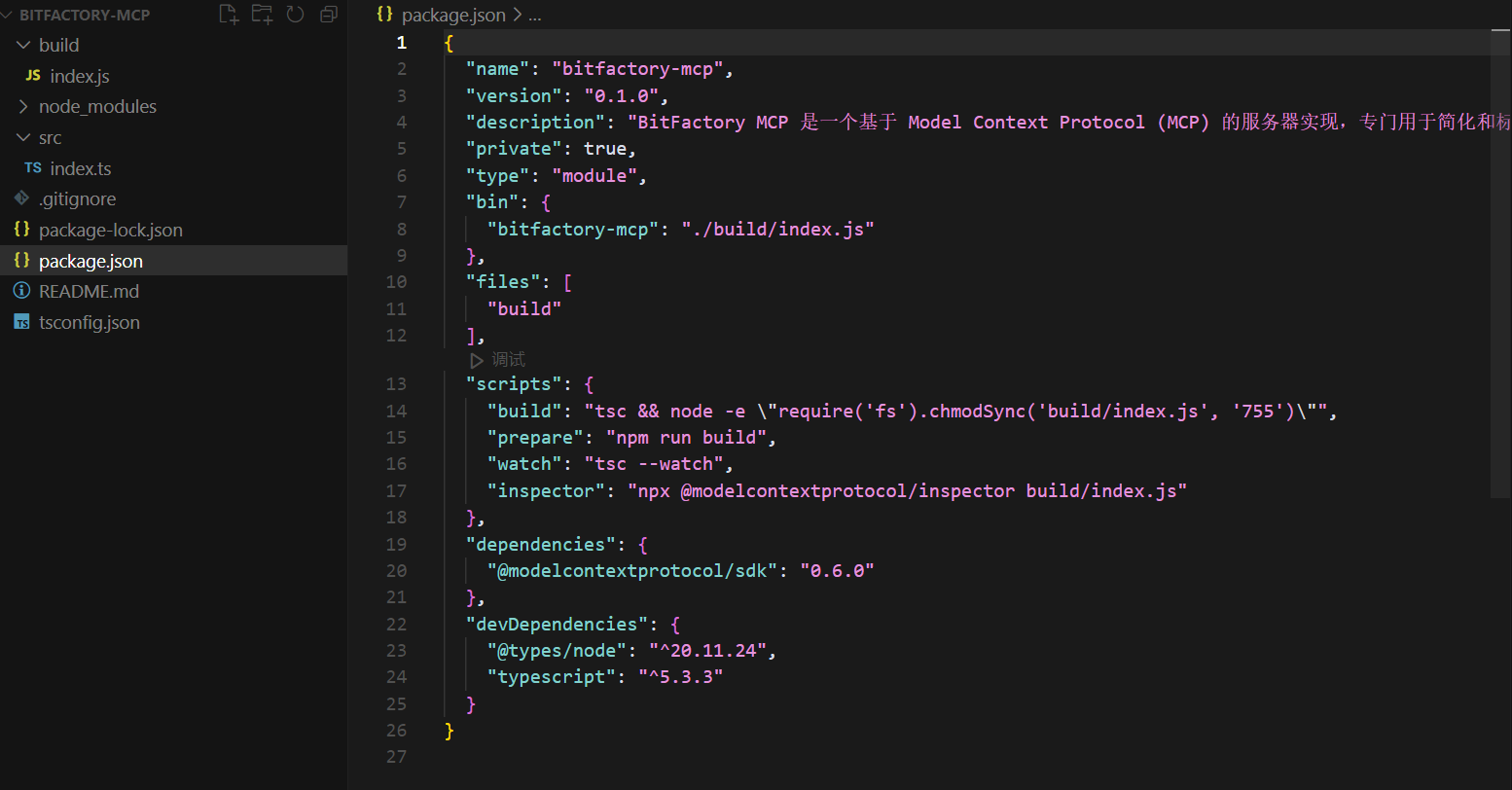
调试MCP服务器
在 MCP 服务器项目目录下,运行 npm run watch 启动一个监听服务,监听 src/index.ts 源码文件的内容变动,并实时编译成 build/index.js 可执行文件。
在 MCP 服务器项目目录下,运行 npm run inspector,实际执行的命令是:

此命令用到了 MCP 官方开发的一个调试工具,运行 MCP 服务器可执行文件,连接到 MCP 服务器进行功能调试。


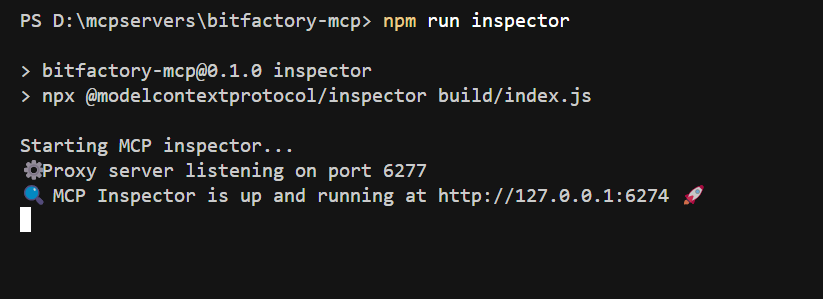
点击调试面板运行地址,进入 MCP 服务器调试面板。
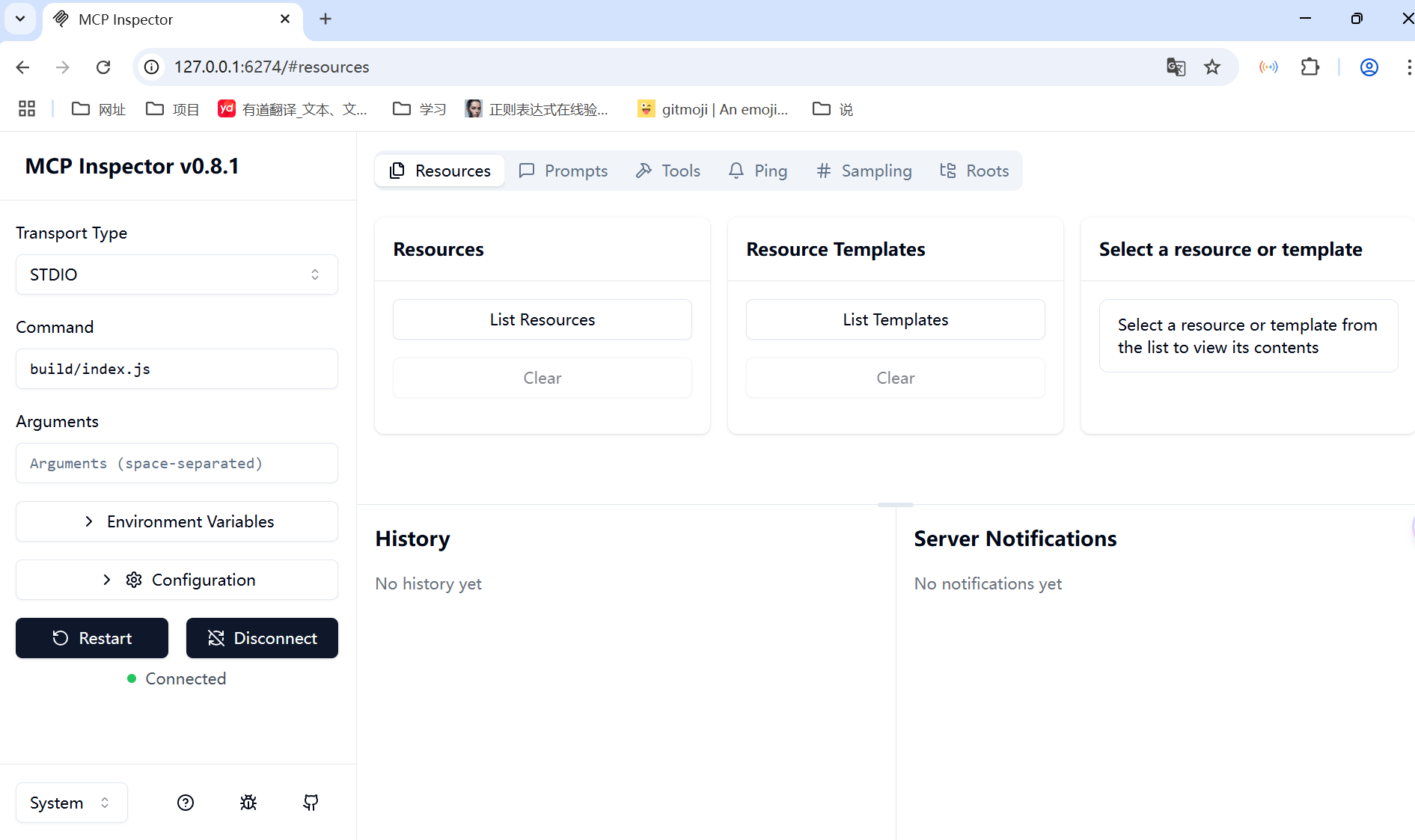
在 MCP 服务器调试面板,点左侧的 Connect 可以连接到 MCP 服务器进行调试,显示 Connected 表示连接成功。
可以设置 MCP 服务器启动参数 Arguments 和环境变量 Environment Variables,在 MCP 服务器实现逻辑中可以读取这两部分的参数值。
MCP 服务器调试面板右侧主要用于请求 MCP 服务器内部定义的资源(Resources)、提示词(Prompts)、工具(Tools)等内容。
我们可以在右侧的 Tools 栏目点 List Tools 获取 MCP 服务器内部实现的所有工具(Tools)。
实现MCP服务器业务逻辑
1. 定义MCP服务器信息
在src/index.ts文件,通过new Server创建MCP服务器信息(实现tools能力)。
const server = new Server(
{
name: "bitfactory-mcp",
version: "0.0.1",
},
{
capabilities: {
tools: {},
},
}
);
2. 定义MCP服务器工具列表
修改 src/index.ts 文件中默认生成的获取工具列表(ListTools)的逻辑,定义一个 getAccount 方法,写上功能描述,说明这个工具(Tool)的作用是获取链上某个账户的信息。
getAccount 工具的参数依据星火链API文档来定义,其中apikey是必填项,api-secret根据用户定义来决定是否要填写,勾选就必须传,否则就不需要。

星火链获取链上某个账户的信息API文档如下图:
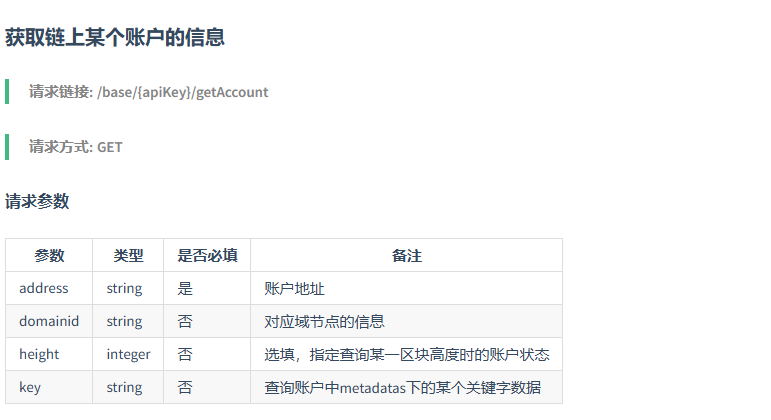
ListTools 的定义如下:
server.setRequestHandler(ListToolsRequestSchema, async () => {
return {
tools: [
{
name: "getAccount",
description: "获取链上某个账户的信息",
inputSchema: {
type: "object",
properties: {
apiKey: {
type: "string",
description: "API key for authentication"
},
apiSecret: {
type: "string",
description: "header apiSecret"
},
address: {
type: "string",
description: "账户地址"
},
domainid: {
type: "string",
description: "对应域节点的信息"
},
height: {
type: "number",
description: "选填,指定查询某一区块高度时的账户状态"
},
key: {
type: "string",
description: "查询账户中metadatas下的某个关键字数据"
}
},
required: ["apiKey", "apiSecret", "address", "domainid", "height", "key"]
}
}
]
};
});
3. 实现MCP服务器工具(Tool)逻辑
我们先创建一个新的文件,src/client.ts,定义一个BitFactoryClient类,实现sendGet和getAccount方法,其中sendGet方法是查询类(GET请求)API的通用方法,getAccount方法是获取链上某个账户信息的方法。
export class BitFactoryClient{
private readonly apiUrl: string;
/**
* Create a new Query client
* @param apiUrl - The API URL
*/
constructor({ apiUrl }: { apiUrl: string }) {
this.apiUrl = apiUrl;
}
/**
* Send a query request
* @param apiSecret - The API secret (optional)
* @returns The response from the API
*/
async sendGet({ apiSecret, path, params }: { apiSecret?: string, path?: string, params?: Record<string, string | number | boolean> } = {}): Promise<string> {
try {
const headers: Record<string, string> = {
'accept': '*/*'
};
if (apiSecret) {
headers['api-secret'] = apiSecret.trim();
}
let url = this.apiUrl;
if (path) {
url += `/${path}`;
}
if (params) {
const queryParams = new URLSearchParams();
Object.entries(params).forEach(([key, value]) => {
if (value !== undefined) {
queryParams.append(key, String(value));
}
});
const queryString = queryParams.toString();
if (queryString) {
url += `?${queryString}`;
}
}
const response = await fetch(url, {
method: "GET",
headers
});
const responseText = await response.text();
if (!response.ok) {
throw new Error(`Request failed with status ${response.status}: ${response.statusText}\nResponse: ${responseText}`);
}
return responseText;
} catch (error: unknown) {
if (error instanceof Error) {
throw new Error(`Query request failed: ${error.message}`);
}
throw new Error('Query request failed: Unknown error');
}
}
/**
* Get account information
* @param apiSecret - The API secret
* @param address - The account address
* @param domainid - The domain ID
* @param height - The block height
* @param key - The key to query
* @returns The account information
*/
async getAccount({apiSecret, address, domainid, height, key }:
{ apiSecret: string, address: string, domainid?: string, height?: number, key?: string }): Promise<string> {
try {
if (!address) {
throw new Error("Account address is required");
}
const params: Record<string, string | number> = {
address
};
if (domainid !== undefined) {
params.domainid = domainid;
}
if (height !== undefined) {
params.height = height;
}
if (key !== undefined) {
params.key = key;
}
const responseText = await this.sendGet({
apiSecret: apiSecret,
path: 'getAccount',
params
});
return responseText;
} catch (error: unknown) {
if (error instanceof Error) {
throw new Error(`Get chain account failed: ${error.message}`);
}
throw new Error('Get chain account failed: Unknown error');
}
}
然后,修改CallTool的逻辑,接到getAccount请求时,先获取参数,校验必填参数后,再调用QueryClient的getAccount方法。
server.setRequestHandler(CallToolRequestSchema, async (request) => {
switch (request.params.name) {
case "getAccount": {
const args = request.params.arguments;
if (!args || typeof args !== 'object') {
throw new Error("Invalid arguments provided");
}
const apiKey = String(args.apiKey || "").trim();
const apiSecret = String(args.apiSecret || "").trim();
const address = String(args.address || "").trim();
const domainid = args.domainid !== undefined ? String(args.domainid) : undefined;
const height = args.height !== undefined ? Number(args.height) : undefined;
const key = args.key !== undefined ? String(args.key) : undefined;
if (!apiKey) {
throw new Error("apiKey is required");
}
if (!address) {
throw new Error("address is required");
}
const baseUrl = `https://bif-testnet.bitfactory.cn/base/${apiKey}`;
const bitFactoryClient = new BitFactoryClient({ apiUrl: baseUrl });
try {
const result = await bitFactoryClient.getAccount({apiSecret, address, domainid, height, key });
const jsonResult = JSON.parse(result);
return {
content: [{
type: "text",
text: JSON.stringify(jsonResult, null, 2)
}]
};
} catch (error: unknown) {
if (error instanceof Error) {
throw new Error(`Get chain account failed: ${error.message}`);
}
throw new Error('Get chain account failed: Unknown error');
}
}
default:
throw new Error("Unknown tool");
}
});
4. 调试MCP服务器工具(Tool)
在调试工具选择 getAccount工具,填入参数,点击 Run Tool,查看工具的调用结果:
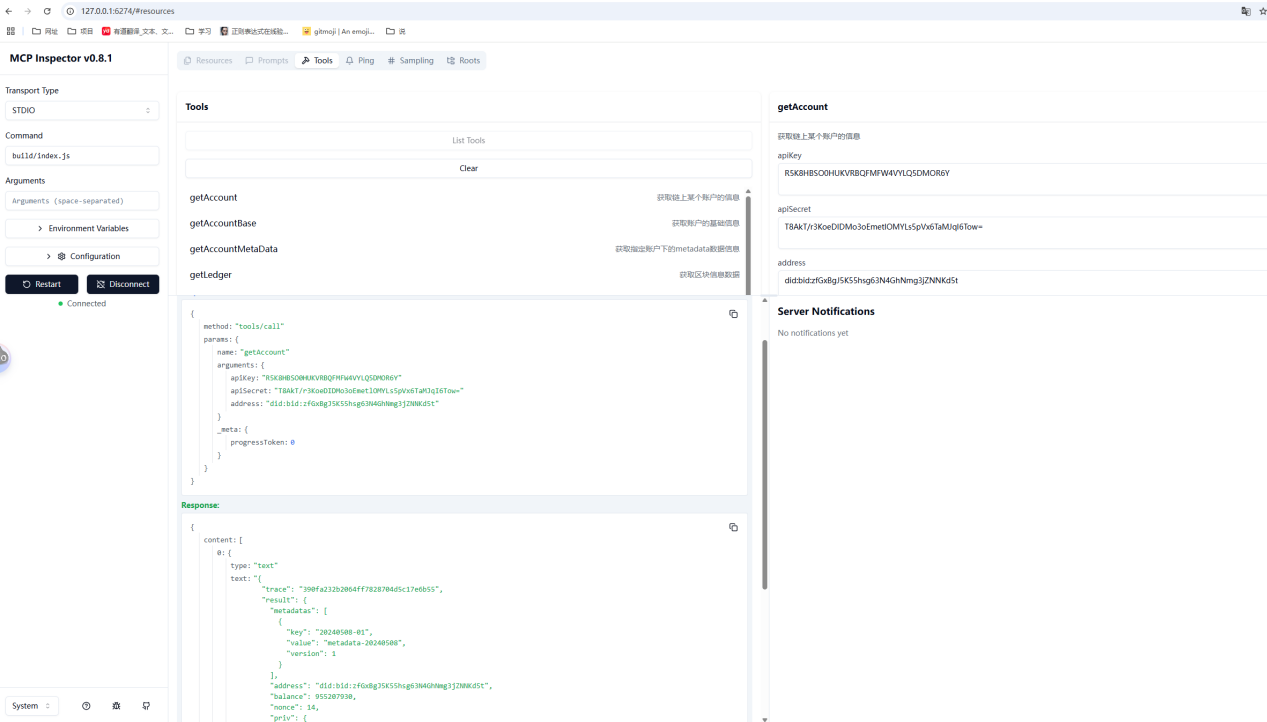
在MCP客户端测试
使用Cursor编辑器,作为 MCP 客户端。来测试我们开发的 bitfactory-mcp 服务器。
首先,打开 Cursor 的 MCP 服务器配置文件。
{
"mcpServers": {
"bitfactory-mcp":{
"command":"node",
"args":["build/index.js 的绝对路径"]
}
}
}
写入连接 bitfactory-mcp 的配置:
args 里面填写 bitfactory-mcp 服务编译后文件的绝对地址。
在 Cursor 的 MCP 配置面板,可以看到bitfactory-mcp 服务已经成功运行,并且获取到了可用的 Tools。
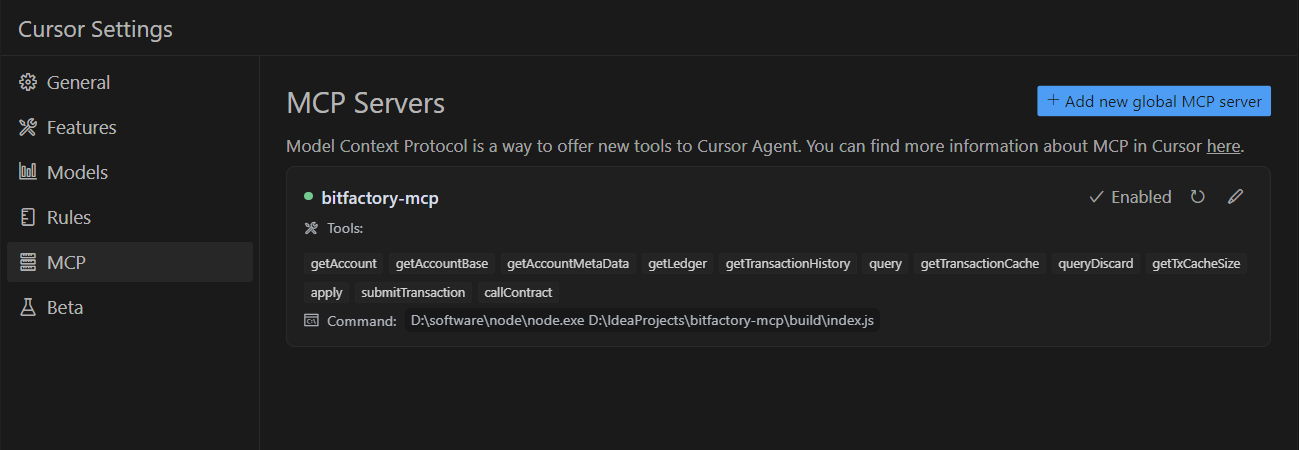
打开 Cursor AI 对话面板,选择 Agent 模式,输入以下或类似内容:

Cursor 会加载所有已配置的可用的 Tools 进行意图识别,识别到意图是获取链上账户信息,会自动调用 bitfactory-mcp 服务的 getAccount 工具。
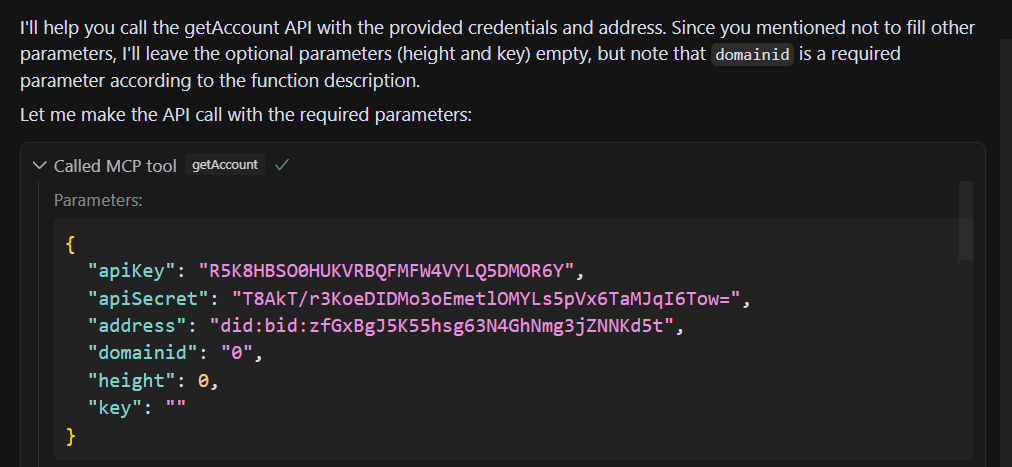
调用结果如下:
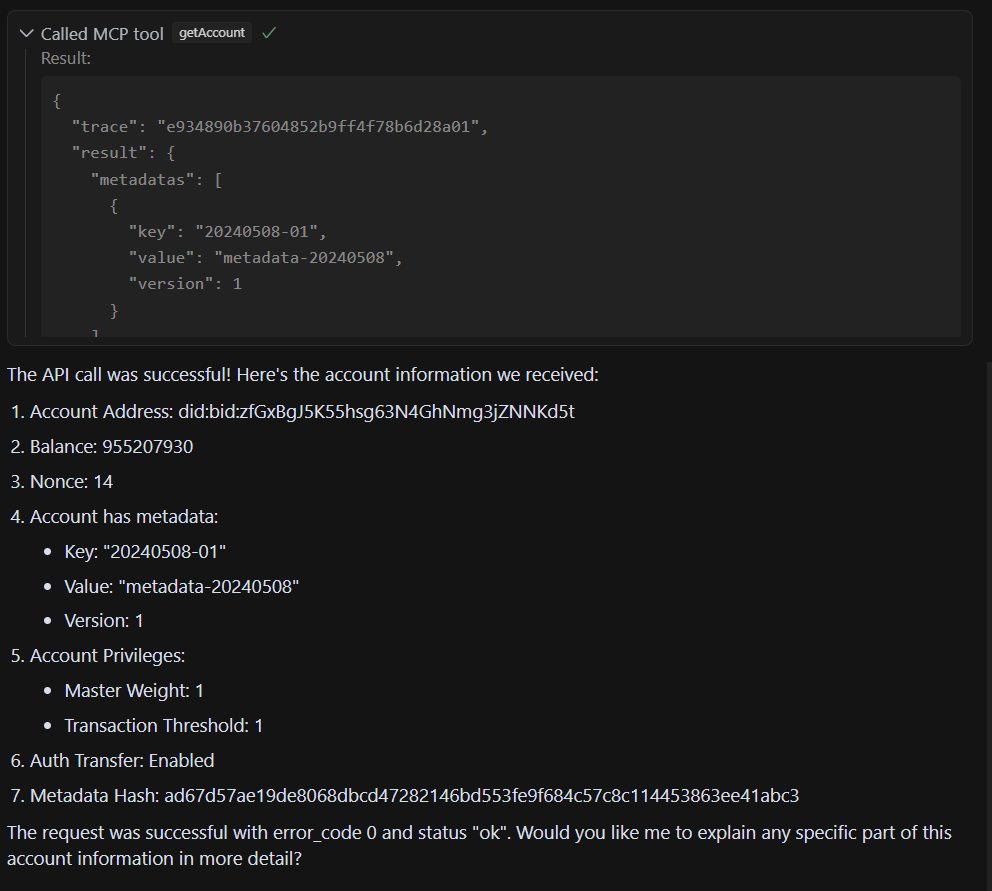




















 872
872

 被折叠的 条评论
为什么被折叠?
被折叠的 条评论
为什么被折叠?








